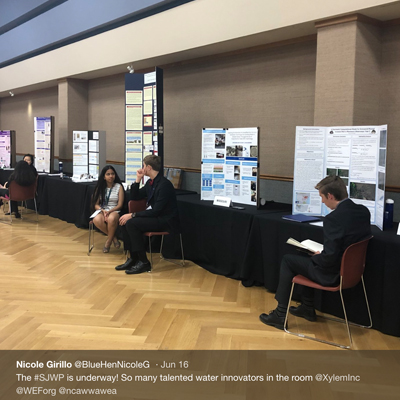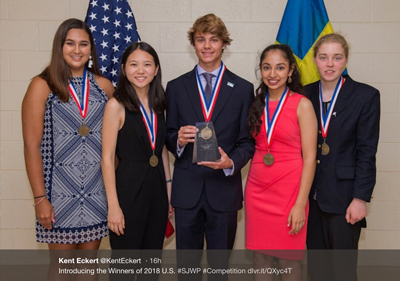News Wonder how to solve a global water challenge? Ask a high schooler!
June 21, 2018

What do teenagers really know about the water challenges facing our planet? A lot, as it turns out, and some are finding creative ways to solve them.
We met 58 of these young researchers this June at the US national competition for the Stockholm Junior Water Prize (SJWP). SJWP is the world’s most prestigious award for youth-led water-related research. It was founded in 1997 by the Stockholm International Water Institute (SIWI) to cultivate a future generation of global water sector leaders. The prize is a complement to the Stockholm Water Prize, which many refer to as the Nobel Prize for water.
J-WAFS and MIT became involved for the first time this year in the US SJWP competition through our partnership with Xylem, Inc., a J-WAFS research affiliate. Xylem is a major sponsor of the prize competition. From June 15 to June 17, 2018, Anselmo Cassiano, an MIT research affiliate in water and climate change, and J-WAFS staff members Andi Sutton and Jasmine Edo traveled to Charlotte, North Carolina, volunteering their time as judges and coaches as 58 students representing 47 US states and the territory of Puerto Rico presented their research and competed for the US title and the opportunity to compete in the global Stockholm Junior Water Prize.
The competitors, ages 15 to 18 years old, had secured their positions through state science competitions, and many applied sophisticated research strategies and analyses to their science research. Their projects took on a variety of water challenges: microplastics in water ecosystems; new irrigation methods; water safety, filtration, and membranes; ocean acidification and contamination; water remediation; agricultural interventions to protect against drought, and many others. (For a snapshot of the variety of people, projects, and approaches, search #SJWP on Twitter.)
In one example, Bianca Rodriguez Castro, who is from a rural town in Puerto Rico, developed a superabsorbent natural polymer out of yucca, yam peels, and lemon. After a two-month series of tests, she was able to prove that this natural, affordable, and easy to make soil additive retains as much moisture growth during drought conditions as the acrylic media that is presently used. After Hurricane Maria, road access to her village was limited, and, still without power, her community struggled to get sufficient food and water. So, during that time she put this polymer prototype to use, teaching people in her community how to use it so they could minimize their agricultural water use while the infrastructure of the island is being repaired. In another, Robert Szymczyk of Illinois studied the extent to which common water pollutants affect the reproduction of Culex qinquefasciatus, the mosquito species that spreads West Nile virus and malaria. He used his research results to make an argument for directing investment into improvements in water treatment infrastructure as a disease control method as an alternative to existing methods for controlling mosquito populations.

The winner of the US competition was from Oklahoma. Braden Milford is developing a bioremediation strategy for heavy metal contamination from EPA Superfund mine sites using algae and microbial isolates. He will receive a $10,000 college scholarship and an all-expenses-paid trip to World Water Week in Stockholm, where he will compete against high school students from around the world at the international Stockholm Junior Water Prize. The two US runners-up were Anjali Chadha of duPont Manual High School in Louisville, Kentucky, and Michelle Xing of Great Neck South High School in Lake Success, New York, who each received $1,000. Madeline Kane of the Zoo Academy in Omaha, Nebraska, received the Bjorn von Euler Innovation in Water Scholarship Award from Xylem Inc. Helen Laird of Interior District Education of Alaska received the James L. Condon Recognition for Environmental Stewardship.
